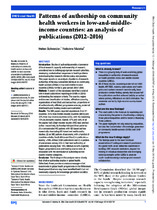| dc.contributor.author | Schneider, Helen | |
| dc.contributor.author | Maleka, Nelisiwe | |
| dc.date.accessioned | 2018-05-16T07:17:15Z | |
| dc.date.available | 2018-05-16T07:17:15Z | |
| dc.date.issued | 2018 | |
| dc.identifier.citation | Schneider, H. & Maleka, N. (2018). Patterns of authorship on community health workers in low-and middle-income countries: an analysis of publications (2012–2016). BMJ Glob Health, 3: e000797. | en_US |
| dc.identifier.issn | 2059-7908 | |
| dc.identifier.uri | http://dx.doi.org/10.1136/ bmjgh-2018-000797 | |
| dc.identifier.uri | http://hdl.handle.net/10566/3675 | |
| dc.description.abstract | INTRODUCTION Studies of authorship provide a barometer
of local research capacity and ownership of research,
considered key to defining appropriate research priorities,
developing contextualised responses to health problems
and ensuring that research informs policy and practice.
This paper reports on an analysis of patterns of research
authorship of the now substantial literature on community
health workers (CHWs) in low-and-middle-income
countries (LMICs) for the 5-year period: 2012–2016.
METHODS A search of five databases identified a total of
649 indexed publications reporting on CHWs in LMICs
and meeting the inclusion criteria. The country, region
and income classification of studies, affiliations (country,
organisation) of lead (first) and last authors, proportions of
all authors locally affiliated, programme area (eg, maternal
child health) and funding source were extracted.
RESULTS The 649 papers reported experiences from 51
countries, 55% from middle-income countries (MICs) and
32% from low-income countries (LICs), with the remaining
13% multicountry studies. Overall, 47% and 54% of all
the papers had a high-income country (HIC) lead and last
author, respectively. Authorship followed three patterns:
(1) a concentrated HIC pattern, with US-based authors
numerically dominating LIC-based and multicountry
studies; (2) an MIC pattern of autonomy, with a handful of
countries—India, South Africa and Brazil, in particular—
leading >70% of their CHW publications and (3) a pattern
of unevenness among LICs in their lead authorship of
publications varying from 14% (Malawi) to 54% (Uganda).
Region, programme area and funding source were all
associated with the distribution of authorship across
country income categories.
CONCLUSION The findings in this analysis mirror closely
that of other authorship studies in global health.
Collectively these provide a common message—that
investments in global health programmes in the Millennium
Development Goal era may have benefited health but not
necessarily capacity for knowledge generation in LMICs. | en_US |
| dc.language.iso | en | en_US |
| dc.publisher | BMJ Publishing Group | en_US |
| dc.rights | Open Access This is an Open Access article distributed in accordance with the
Creative Commons Attribution Non Commercial (CC BY-NC 4.0) license, which
permits others to distribute, remix, adapt, build upon this work non-commercially,
and license their derivative works on different terms, provided the original work is
properly cited and the use is non-commercial. See: http:// creativecommons. org/
licenses/ by- nc/ 4. 0/ | |
| dc.subject | Studies of authorship | en_US |
| dc.subject | Policy and practice | en_US |
| dc.subject | Community health workers | en_US |
| dc.subject | Low-and-middle-income countries (LMICs) | en_US |
| dc.title | Patterns of authorship on community health workers in low-and-middle-income countries: an analysis of publications (2012–2016) | en_US |
| dc.type | Article | en_US |
| dc.privacy.showsubmitter | FALSE | |
| dc.status.ispeerreviewed | TRUE | |

